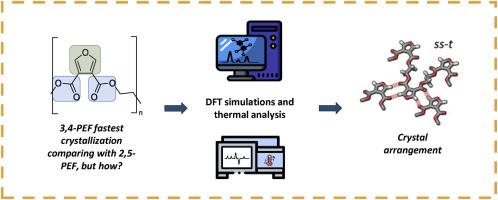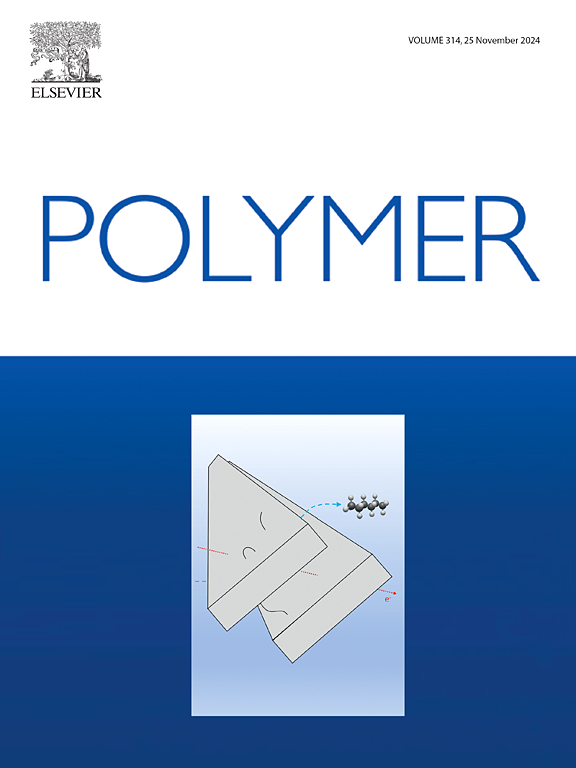揭示了3,4- pef不寻常的结晶特征,热分析和DFT研究
IF 4.1
2区 化学
Q2 POLYMER SCIENCE
引用次数: 0
摘要
基于呋喃二甲酸(FDCA)的聚合物和材料的发展是学术界和工业界快速发展的研究领域,这是由更可持续的替代品取代化石基聚合物的需求所驱动的。尽管聚(乙烯2,5-呋喃二羧酸酯)(2,5- pef)具有明确的潜力,但许多其他的呋喃聚酯,如聚(乙烯3,4-呋喃二羧酸酯)(3,4- pef),由3,4- fdca异构体合成,仍未得到充分开发。这项研究首次利用振动光谱和密度泛函理论计算来探索3,4- pef聚酯的构象偏好。此外,3,4- pef的综合热表征解决了文献中的电流空白。结果表明,在晶体结构域中,3,4- pef链为ss-t构象,其中3,4- fdca片段为syn-syn基序,乙二醇(EG)片段为反式构象(ss-t)。然而,在非晶态区域,多种构象共存,同步-同步-间扭式(ss-g)和反同步-间扭式(as-g)片段占了大部分的人口分布。正如之前在2,5- pef中观察到的那样,在结晶域中形成C-H···O相互作用是3,4- pef结晶偏好的主要驱动因素。链间C-H··O键形成带来的能量增益补偿了从ss-g/as-g到ss-t构象转变带来的能量损失。差示扫描量热法(DSC)分析表明,3,4- pef的玻璃化转变温度(Tg)为39℃,熔融温度(Tm)为155℃。动力学研究表明,3,4- pef的最快结晶速率发生在110℃,半结晶时间为12 min。有趣的是,在最佳结晶温度(170℃)下,3,4- pef的结晶速度比2,5- pef快,但仍比聚对苯二甲酸乙酯慢。这些发现表明3,4- pef有望成为一种具有快速结晶行为的可再生聚合物。本文章由计算机程序翻译,如有差异,请以英文原文为准。

Unveiling the uncommon crystallization features of 3,4-PEF, a thermal and DFT study
The development of furandicarboxylic acid (FDCA) based polymers and materials is a rapidly growing research field in both academia and industry, driven by the need to replace fossil-based polymers with more sustainable alternatives. Despite the unequivocal potential of poly(ethylene 2,5-furandicarboxylate) (2,5-PEF), many other furanic polyesters, such as poly(ethylene 3,4-furandicarboxylate) (3,4-PEF), synthetized from the 3,4-FDCA isomer, remain underexplored. This study is the first to explore the conformational preferences of 3,4-PEF polyester using vibrational spectroscopy and density functional theory calculations. Additionally, a comprehensive thermal characterization of 3,4-PEF addresses current gaps in the literature.The results suggest that, in crystalline domains, 3,4-PEF chains adopt the ss-t conformation, where the 3,4-FDCA segment exhibits a syn-syn motif and the ethylene glycol (EG) segment is in the trans conformation (ss-t). In amorphous regions, however, multiple conformations coexist, with syn-syn-gauche (ss-g) and anti-syn-gauche (as-g) segments accounting for the bulk of the population distribution. As previously observed for 2,5-PEF, the formation of C-H···O interactions in the crystalline domain is the main driver for the crystallization preferences of 3,4-PEF. The energetic gain from interchain C-H···O bond formation compensates for the energy penalty associated with the ss-g/as-g to ss-t conformational transition.Differential scanning calorimetry (DSC) analysis revealed that 3,4-PEF has a glass transition temperature (Tg) of 39 °C and a melting temperature (Tm) of 155 °C. Kinetic studies showed that the fastest crystallization rate for 3,4-PEF occurs at 110 °C, with a half crystallization time of 12 min. Interestingly, 3,4-PEF crystallizes faster than 2,5-PEF at its optimal crystallization temperature (170 °C), though still more slowly than poly(ethylene terephthalate). These findings suggest that 3,4-PEF holds promise as a renewable polymer with fast crystallization behaviour.
求助全文
通过发布文献求助,成功后即可免费获取论文全文。
去求助
来源期刊

Polymer
化学-高分子科学
CiteScore
7.90
自引率
8.70%
发文量
959
审稿时长
32 days
期刊介绍:
Polymer is an interdisciplinary journal dedicated to publishing innovative and significant advances in Polymer Physics, Chemistry and Technology. We welcome submissions on polymer hybrids, nanocomposites, characterisation and self-assembly. Polymer also publishes work on the technological application of polymers in energy and optoelectronics.
The main scope is covered but not limited to the following core areas:
Polymer Materials
Nanocomposites and hybrid nanomaterials
Polymer blends, films, fibres, networks and porous materials
Physical Characterization
Characterisation, modelling and simulation* of molecular and materials properties in bulk, solution, and thin films
Polymer Engineering
Advanced multiscale processing methods
Polymer Synthesis, Modification and Self-assembly
Including designer polymer architectures, mechanisms and kinetics, and supramolecular polymerization
Technological Applications
Polymers for energy generation and storage
Polymer membranes for separation technology
Polymers for opto- and microelectronics.
 求助内容:
求助内容: 应助结果提醒方式:
应助结果提醒方式:


